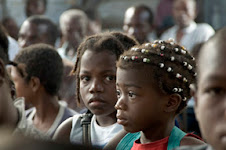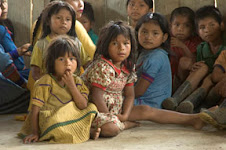Primero, un cuentito turistico—tanto al llegar como al salir del museo , se me acercaron hombres que descubrieron un papelito que desplegaron para mostrar “esmeraldas” (o pedazos de vidrio verde). Me aseguraron, de voz baja, que eran “esmeraldas legítimas,” y que se vendían “muy baratas.” Seguro que sí…
Now, thinking about gold mining and the museum a little more. Since this is in reality an exhibit of ancient pieces, and a discussion of the cultural meaning of these pieces within different indigenous cultures, something curious happens, according to what I understand. With the arrival of the Spanish conquistadors, gold mining becomes a much more intensive activity, quasi-industrial, and it is carried out largely by African slaves. The indigenous people are forced away from the mining areas.
There are no beautiful pieces of jewelry, body adornment or household goods in the museum that date from this point on. Why? I presume that it’s for the simple reason that instead of being destined for this uses, the gold was sent as treasure (as booty?) for the Spanish crown.
Among other things, this means that the exhibit at the museum stops just at the time that large numbers of African people begin working there. Nor is there any discussion of the loss of the gold for native peoples.
In the area that I know, El Chocó, the history of gold mining from that point on is very interesting. It’s connected with the repression of native peoples, with the development of slavery, and therefore of the large Afro-Colombian population on the Pacific coast, and even with the influence and power of foreign companies. Today, gold mining with big backhoes represents a threat both to the special environment of the area and to the collective communal rights of the Afro-Colombian and indigenous communities.
In the end, there’s something wrong with a Museum of Gold that completely ignores all this. I wonder if there expanded exhibition space will include materials about these topics.
Here are a couple of pictures of mine from previous visits, to give a sense of the destructive power of current mining practices in that area, even on the relatively small scale that they exist compared with mining projects in other parts of the world.. (You'll find the pictures at the bottom of this post)
Ya, pensamos un poco más sobre el museo y la minería. Como de hecho se trata de una exposición de piezas antiguas, y una presentación del significado cultural de estas piezas para varias culturas indígenas, sucede algo curioso, según lo que entiendo. Con la llegada de los conquistadores españoles, la minería vuelve una actividad mas intensiva, quasi industrial, y se realiza en gran parte por esclavos africanos. La gente indígena se ve sacada de la mina.
No hay bellas joyas, adornos del cuerpo o bienes domésticos en el museo de este punto en adelante. ¿Por qué? Presumo que sea por el simple razón que en lugar de ser destinado a esas ocupaciones el oro fue enviado como tesoro (¿botín?) para la corona española.
Entre otra cosas, quiere decir que la exposición en el museo termina justamente al momento en que grandes cantidades de africanos empiezan a trabajar allá. Tampoco hay nada sobre lo que significaba la pérdida del oro para los pueblos indígenas.
En la zona que conozco, El Chocó, la historia de la minería del oro desde aquel momento es muy interesante. Está relacionada con la represión de los pueblos nativos, con el desarrollo del sistema esclavista, y por ende de la población grande afro-colombino en la costa pacífica, y hasta con la incidencia y el poder de empresas extranjeras. Hoy la minería con retroexcavadoras grandes representa una amenaza tanto al medio ambiente especial de la zona como a los derechos comunales colectivos de las comunidades afro-colombianas y indígenas.
Al fin de la cuenta, hay algo incorrecto cuando un Museo del Oro ignora totalmente todo esto. Me pregunto si en sus nuevas salas de exposición habrá materiales sobre estos temas.
Aquí hay un par de fotos mías de visitas anteriores a la zona, para dar una idea del poder destructivo de las prácticas actuales mineras de esa zona, por relativamente menor que sea la escala de está, comparado con proyectos en otras partes del mundo.





1 comment:
Steve,
Your account of gold mining makes me think of the the Simpsons movie I, Deborah and Beth saw last night. It is not such a stretch since the movie revolves around Homer having tipped Springfield's lake into environmental monsterdom by dropping the last measure of pig excrement into it. Later, the Simpsons are environmental refugees, fleeing to Alaska's pristine wilderness, which they find to be a morass of oil wells, shattering Homer's illusions.
Greetings from Cleveland, where sending postcards is much cheaper. Now we need tourists to send them.
Jim M.
Post a Comment